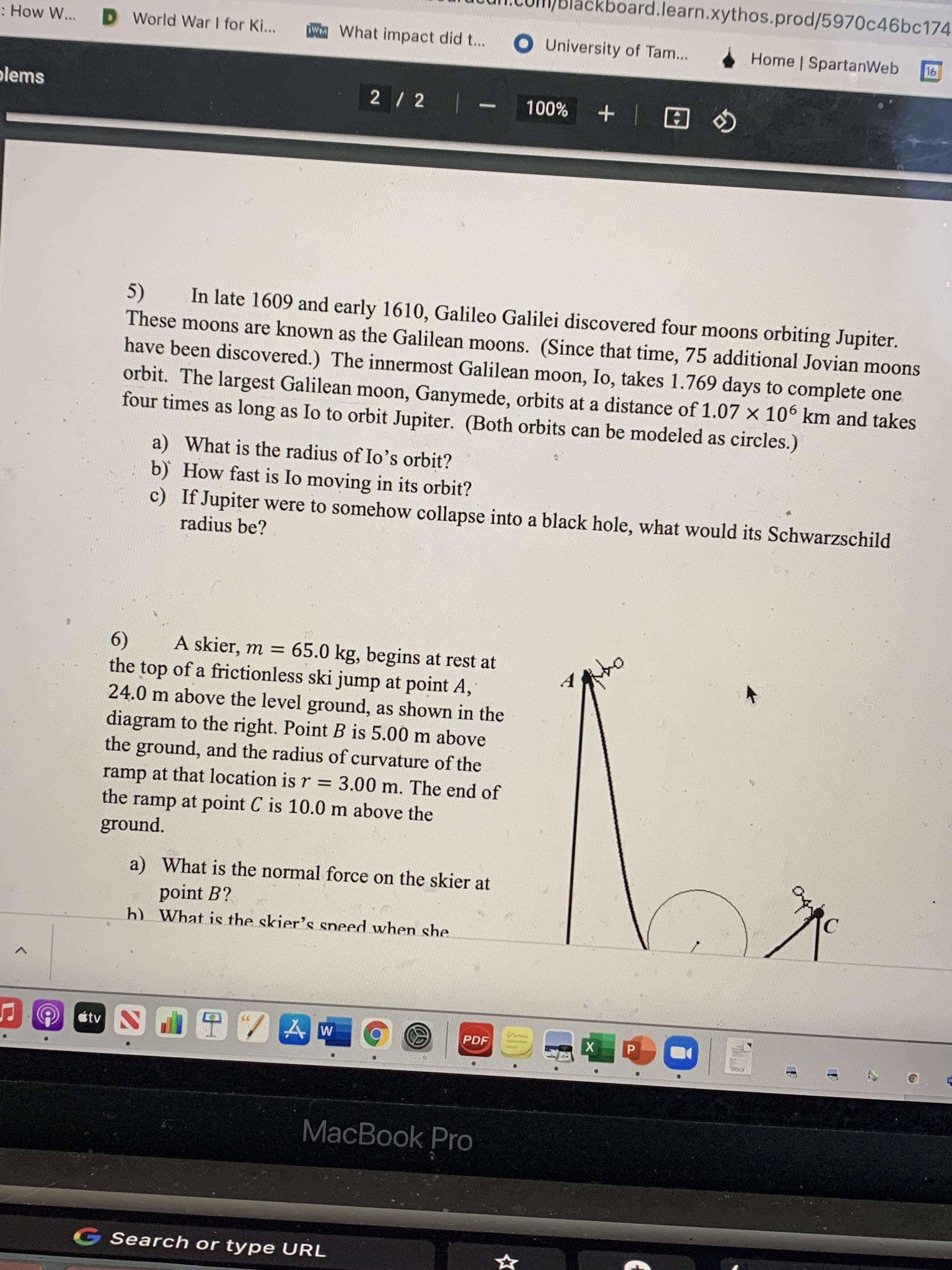In late 1609 and early 1610, Galileo Galilei discovered four moons orbiting Jupiter. 5) These moons are known as the Galilean moons. (Since that time, 75 additional Jovian moons have been discovered.) The innermost Galilean moon, Io, takes 1.769 days to complete one orbit. The largest Galilean moon, Ganymede, orbits at a distance of 1.07 x 106 km and takes four times as long as Io to orbit Jupiter. (Both orbits can be modeled as circles.) a) What is the radius of Io's orbit? b) How fast is Io moving in its orbit? c) If Jupiter were to somehow collapse into a black hole, what would its Schwarzschild radius be?
In late 1609 and early 1610, Galileo Galilei discovered four moons orbiting Jupiter. 5) These moons are known as the Galilean moons. (Since that time, 75 additional Jovian moons have been discovered.) The innermost Galilean moon, Io, takes 1.769 days to complete one orbit. The largest Galilean moon, Ganymede, orbits at a distance of 1.07 x 106 km and takes four times as long as Io to orbit Jupiter. (Both orbits can be modeled as circles.) a) What is the radius of Io's orbit? b) How fast is Io moving in its orbit? c) If Jupiter were to somehow collapse into a black hole, what would its Schwarzschild radius be?
Glencoe Physics: Principles and Problems, Student Edition
1st Edition
ISBN:9780078807213
Author:Paul W. Zitzewitz
Publisher:Paul W. Zitzewitz
Chapter7: Gravitation
Section: Chapter Questions
Problem 5STP
Related questions
Question
#5

Transcribed Image Text:In late 1609 and early 1610, Galileo Galilei discovered four moons orbiting Jupiter.
5)
These moons are known as the Galilean moons. (Since that time, 75 additional Jovian moons
have been discovered.) The innermost Galilean moon, Io, takes 1.769 days to complete one
orbit. The largest Galilean moon, Ganymede, orbits at a distance of 1.07 x 106 km and takes
four times as long as Io to orbit Jupiter. (Both orbits can be modeled as circles.)
a) What is the radius of Io's orbit?
b) How fast is Io moving in its orbit?
c) If Jupiter were to somehow collapse into a black hole, what would its Schwarzschild
radius be?
Expert Solution
This question has been solved!
Explore an expertly crafted, step-by-step solution for a thorough understanding of key concepts.
This is a popular solution!
Trending now
This is a popular solution!
Step by step
Solved in 2 steps

Knowledge Booster
Learn more about
Need a deep-dive on the concept behind this application? Look no further. Learn more about this topic, physics and related others by exploring similar questions and additional content below.Recommended textbooks for you

Glencoe Physics: Principles and Problems, Student…
Physics
ISBN:
9780078807213
Author:
Paul W. Zitzewitz
Publisher:
Glencoe/McGraw-Hill

Physics for Scientists and Engineers: Foundations…
Physics
ISBN:
9781133939146
Author:
Katz, Debora M.
Publisher:
Cengage Learning

College Physics
Physics
ISBN:
9781305952300
Author:
Raymond A. Serway, Chris Vuille
Publisher:
Cengage Learning

Glencoe Physics: Principles and Problems, Student…
Physics
ISBN:
9780078807213
Author:
Paul W. Zitzewitz
Publisher:
Glencoe/McGraw-Hill

Physics for Scientists and Engineers: Foundations…
Physics
ISBN:
9781133939146
Author:
Katz, Debora M.
Publisher:
Cengage Learning

College Physics
Physics
ISBN:
9781305952300
Author:
Raymond A. Serway, Chris Vuille
Publisher:
Cengage Learning

Principles of Physics: A Calculus-Based Text
Physics
ISBN:
9781133104261
Author:
Raymond A. Serway, John W. Jewett
Publisher:
Cengage Learning

University Physics Volume 1
Physics
ISBN:
9781938168277
Author:
William Moebs, Samuel J. Ling, Jeff Sanny
Publisher:
OpenStax - Rice University

Astronomy
Physics
ISBN:
9781938168284
Author:
Andrew Fraknoi; David Morrison; Sidney C. Wolff
Publisher:
OpenStax